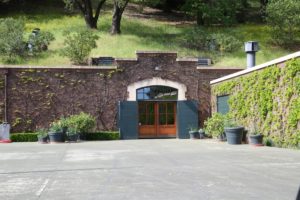
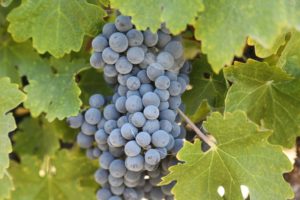
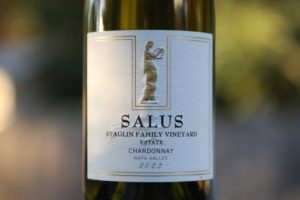 Staglin Family Vineyard is tucked away in a little visited southern part of the Rutherford Appellation, despite being a very short drive from the often busy Highway 29. Their focus is on premium limited production wines; the winery was founded by Sharalyn (Shari) and Garen Staglin (both UCLA graduates from the class of 1966) and their two children Brandon and Shannon. Garen’s family surname used to be Stagliano but when naturalized, his father changed it to Staglin. Their appreciation for Napa Valley began in the 1960s; Garen graduated from Stanford Business School in 1968 with a master’s degree in Business Administration; during breaks from college, he and Shari would visit Napa Valley. An engineer by training, he has been involved in a number of businesses throughout his career including as CEO of Safelite Glass Corp (replacing windshields and windows in automobiles) and in private equity, venture capital and payment and credit card processing services.
Staglin Family Vineyard is tucked away in a little visited southern part of the Rutherford Appellation, despite being a very short drive from the often busy Highway 29. Their focus is on premium limited production wines; the winery was founded by Sharalyn (Shari) and Garen Staglin (both UCLA graduates from the class of 1966) and their two children Brandon and Shannon. Garen’s family surname used to be Stagliano but when naturalized, his father changed it to Staglin. Their appreciation for Napa Valley began in the 1960s; Garen graduated from Stanford Business School in 1968 with a master’s degree in Business Administration; during breaks from college, he and Shari would visit Napa Valley. An engineer by training, he has been involved in a number of businesses throughout his career including as CEO of Safelite Glass Corp (replacing windshields and windows in automobiles) and in private equity, venture capital and payment and credit card processing services.
He and Shari lived in the San Francisco Bay Area for a number of years; in 1985 they purchased a 50-acre piece of land owned by Dagmar de Pins the granddaughter of Georges de LaTour (Beaulieu Vineyard founder) and her husband Walter Sullivan and in 1987, the 12-acre hillside adjoining parcel. The Sullivan family acquired this property in 1963; they still own a part of the original Beaulieu Vineyard estate, the gorgeous Beaulieu Gardens, today used for private events including a limited number of weddings. The property at the time was planted to 40 acres of Cabernet Sauvignon and 10 acres of Chardonnay. The first vintage bottled as Staglin Family Vineyard was in 1986, a Cabernet Sauvignon.
An early owner of the property was Serranus Clinton Hastings. Hastings was born in New York and came to California in 1849, initially settling in Benicia. He became the 1st Chief Justice of California in 1849 and was California’s Attorney General in the early 1850s. By the early 1860s he was a sizable land owner in northern California. And article in the St. Helena Star dated March 17, 1882 describes his real estate holdings as 100 lots in San Francisco with other properties in Solano, Napa, Lake and Sacramento counties.
Hastings funded UC Berkeley’s Hastings School of Law with a donation of $100,000 in 1878. This school kept his name through 2023 when it was changed to UC Law San Francisco after it came to light Hastings direct involvement helping to facilitate genocide against Native Americans. He died in 1893 and is buried in the St. Helena Cemetery.
This is one of Napa Valley’s most historic vineyards; in 1864, 367 acres were sold by Hastings to John and Mary (Harris) Steckter. The Steckter’s planted about 60 acres of grapes after acquiring the property. They sold their grapes to local wineries including Brun & Chaix, today the site of Napa Wine Co in Oakville. Over the years they sold off pieces of their property including in 1880, 60 acres and in 1883, 73 acres.
In the 1870s John Steckter also owned a lumber business in St. Helena. According to an article in the July 20, 1877 issue of the St. Helena Star he sold his business to Jno. Even & Co.
Rutherford was a very tight knit community back then, and it still is. Mary’s family was deeply rooted in Rutherford; her brother Henry Harrison Harris (a Napa County Sheriff for two terms) founded H. H. Harris Cellar in 1887, the current home of Martin Estate and the property where Beaulieu Vineyard produced some of their early vintages in the early 1900s. Henry was married to Lurinda/Lucinda (Stice), one of 19 children and part of a prominent early pioneer family to Napa Valley. Henry Stice was the winemaker for H.H. Harris Cellars but was also hired as the Beaulieu’s winemaker in 1909. Other Stice family members later became winemakers in Napa Valley.
John Steckter’s obituary in 1892 describes him as one of the pioneers of Napa Valley. After his passing, his widow Mary and her brother Henry were appointed executors of his estate. Mary eventually moved to the city of Napa in 1907 to be with her son, Napa County Sheriff John Pressley Steckter. According to an article dated January 27, 1939 in The St. Helena Star celebrating Mary’s 103 birthday, she and her husband donated land to build the Rutherford schoolhouse. She died a month later; her obituary listed her as Napa county’s oldest resident and at the time of her summons, she was a great great grandmother 8x over.
In 1922 the property was purchased by Frank Manley (1867 – 1933) who had become wealthy through oil and gold in Alaska and California. He first came to Alaska in the late 1890s, a time of the Klondike Gold Rush. A Napa Journal article in the April 27, 1913 issue describes him as already a wealthy mine operator. In his obituary he was described as at one point being the largest single mining operator in the state of Alaska. He built the Hanley Hotel and Natatorium in 1906 in Manley Hot Springs, today about a 4 hour drive from Fairbanks. This was once the largest log building in Alaska (three and a half stories). Unfortunately the main lodge burned down in 1913 – visitors to this tiny community and remote part of Alaska can still stay in the Manley Roadhouse and Lodge.
Along with partners, Manley purchased land in Bakersfield; their venture was very successful. He also invested in oil wells in Texas (his birth state), but these weren’t very profitable. He was involved in what became the First National Bank of Fairbanks (today Key Bank). Manley is in the Alaska Mining Hall of Fame Foundation.
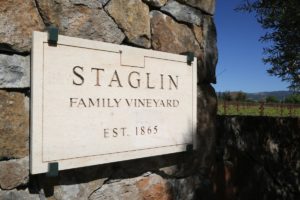
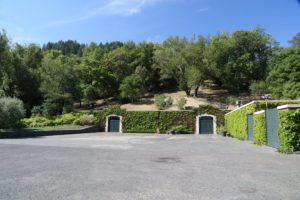
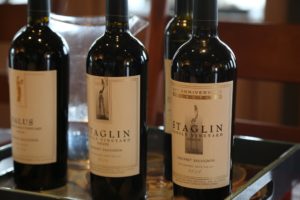 An article in the September 30, 1931 issue of the The Napa Valley Register describes Manley as having recently made a mineralized gold strike at 2,500 feet above Livingston Creek in southern Yukon. But before he could develop the mine, he was severely injured in a car accident involving a truck near Byron Hot Springs on Highway 4 in California (Contra Costa County) in August, 1932 which left him with a concussion and a crushed chest. He died from a heart attack at his home in Rutherford in January 1933.
An article in the September 30, 1931 issue of the The Napa Valley Register describes Manley as having recently made a mineralized gold strike at 2,500 feet above Livingston Creek in southern Yukon. But before he could develop the mine, he was severely injured in a car accident involving a truck near Byron Hot Springs on Highway 4 in California (Contra Costa County) in August, 1932 which left him with a concussion and a crushed chest. He died from a heart attack at his home in Rutherford in January 1933.
On a personal note, relating to California’s gold rush, one of our most noteworthy finds on our former mining claim in the foothills of the Sierra Nevada was a thick copper plate covered with gold and the resulting scratches after miners used quicksilver to extract gold from crushed quartz rock. Apparently they were getting so much gold from this area it wasn’t worth their time to remove the amount of gold still left on the copper plate.
We ended up pulling out about 1.5 pounds of gold from this claim primarily found by using metal detectors; this gave us a brief taste of what things were like during gold strikes in the early days. We would love to go back in time for a month or two and be part of the mining activities in either Alaska or California and the resulting excitement during some of the early major gold finds. It is worth noting that there are numerous personalities over the decades who either owned vineyards or wineries in Napa Valley with connections to California’s early mining history. And some of their heirs continue to produce wine in Napa Valley.
—
Staglin Winery is led by mother and daughter; Shari is the CEO and Shannon is the President. Shari’s previous career is in health care. Shannon’s husband Artie is also involved – he runs a private mailing list only subscriber wine brand called WineXYZ and his one wine brand, Le Artishasic.
Winemaker, soils and viticulture expert André Tchelistcheff originally decided to convert what were prune orchards on the property back into vineyards beginning in 1963. His viticulture knowledge played a prominent role in the types of vines planted here and how the vineyard was laid out. The Staglin’s used his expertise after they purchased the property. We’ve heard differing opinions on whether the grapes from these vines were used in the well-known Georges de Latour Private Reserve label that Beaulieu Vineyard popularized (and still makes today). Regardless this is one of Napa Valley’s sweet spots for growing premium quality wine grapes.
Today the Staglin’s own nearly 62 acres of prime land in the heart of the Rutherford Appellation. Their 51 acres of vineyards are located on coveted bench land soils. These deep slightly gravelly brownish soils were formed during millions of years because of erosion and run off from the nearby Mayacamas mountains. As a result of this type of soil, its excellent drainage and the climate, this is excellent terroir for growing Cabernet Sauvignon.
The property is planted to Cabernet Sauvignon, Petit Verdot, Cabernet Franc and to perhaps two surprising varieties – Chardonnay and Sangiovese. Chardonnay is generally planted in the southern part of Napa Valley closer to the cooling influence of the San Pablo Bay; there is very little Chardonnay currently growing in Rutherford or Oakville. The Staglin’s chose to grow Chardonnay (instead of Cabernet Sauvignon) because Shari enjoys drinking wines from this variety. Their wines are made entirely from estate grown grapes, other than a small amount of Chardonnay that they source.
Vineyard manager David Abreu has managing their vineyards since the Staglin’s purchased the property in 1985 – all of which are certified CCOF; the Staglin’s were among the earlier Napa Valley adopters of the CCOF certification for organic farming. Solar cells on the property supply all of their energy needs. Staglin is in the enviable position on sunny days of providing extra energy back into the grid.
Highly sought after French based blending master Michel Rolland consults for Staglin and helps with their final blending decisions. Over the years a number of Napa Valley’s most accomplished winemakers have made or been involved in the production of the Staglin wines including Cathy Corison, Celia Welch, Bob Levy, Luc Morlet and Andy Erickson.
It is clear that Staglin’s focus is on quality and producing the best possible wines they can from their vineyards.
The actual winery is completely underground; it is self-contained within a 24,000 square foot cave system. Note the very high ceilings – they are much taller than most Napa winery caves. The only exposed portion of the winery is the crush pad located directly outside.
Music Festival for Brain Health
Besides their wines, Staglin is well known for their annual Music Festival for Brain Health event held on site every September. The inspiration for this event came after Shari and Garen’s son Brandon was diagnosed with schizophrenia in 1990. Since the inaugural event in 1995 remarkably (as of 2023) they have raised more than 550 million dollars towards research and medicine for mental health related diseases. The music festival directly benefits One Mind, a research organization also co-founded by Garen and Shari, dedicated to finding cures for brain illnesses and injuries. And until 2024, Brandon was the President of One Mind when his role changed to Chief Advocacy and Engagement Officer.
The Music Festival for Brain Health is one of (if not the largest) annual private Napa winery charity event; it is *the* winery event to attend in the valley. Typically, well-known musicians will headline and about 75 of Napa Valley’s most exclusive wineries are on site pouring their own wines including brands that rarely if ever pour their wines at events. Celebrity or other well-known chefs always prepare the gourmet dinner. Part of the proceeds raised from this event help fund cutting edge research by scientists.
This is not the only fundraiser that Staglin supports; their wine was often one of the higher bids at the annual Auction Napa Valley (now Premiere Napa Valley) and the Naples Winter Wine Festival. They do a remarkable amount of work with charities including fundraising dinners around the country and have directly contributed more than 1 billion dollars to charity efforts to date.
And the Staglin’s support brain research at their Alma mater, UCLA. The Semel Institute on campus in part houses the Staglin One Mind Center for Cognitive Neuroscience. This center is primarily used for education and research purposes. An advanced laboratory contains an MRI machine which can be rented by the hour by research members of the UCLA community.
Select Wines
Staglin Cabernet Sauvignon
The Staglin Cabernet Sauvignons are crafted to be complex wines, and can be enjoyed in their youth, but also have significant aging potential.
The 2014 Staglin Family Vineyard Cabernet Sauvignon is 81% Cabernet Sauvignon, 13% Cabernet Franc and 6% Petit Verdot. This wine is dark ruby in color; it shows a dark fruited component to the bouquet including blackberry and a sweet black licorice nuance. As the wine breathes, additional dessert spices are revealed including cinnamon and mocha. A juicy mouthwatering palate features mostly darker fruit flavors. This wine simultaneously has a softness yet also a richness; it is well layered with depth of flavor. Structurally, the tannins are noticeable but are well-integrated – they are not harsh. This is a fairly approachable wine in its youth from a vintage that generally showed well early on, as compared to the 2013s which tended to need more time in bottle. The finish is extended. Keep or drink now.
The 2004 Staglin Family Vineyard Cabernet Sauvignon shows notes of ripe black cherry with a subtle underlying note of cedar. The palate offers generous layers of flavor including plum, blueberries and subtle notes of pepper especially towards the finish. Firm structure, bright acidity and tasty fruit will ensure this wine will only age gracefully. There is a saying attributed to André Tchelistcheff about the influences of soils in Rutherford on wines from this sub appellation; the ‘Rutherford dust’; this wine offers a bit of that character, most noticeable on the back of the palate.
Salus Chardonnay
There is no Parker Knoll Chardonnay produced here, but a companion label, Salus is named after the Roman goddess for safety and welfare and includes a Chardonnay and a Cabernet Sauvignon with a portion of the proceeds from the sales of these wines donated to research and treatment of schizophrenia, bipolar disorder and depression. The name for this wine originated from a trip to Italy where the Staglin’s first noticed an image of this goddess on a coin. The Salus wines are crafted to be approachable in their youth.
The 2022 Staglin Family Vineyard Salus Chardonnay is medium to deep gold in color; the bouquet offers rich aromatics of baked apples, melting honey, a similar scent that reminds us exactly of pulling trays filled with honey out of our bee hives we used to maintain in Calistoga until they were destroyed by wildfires, ripe pineapple, apricot, peaches, mango, butterscotch and caramelized sugars similar to that of a creme Brule. The oak and butter characteristics are both here but neither one dominates. The palate is rich and partially orchard fruited with flavors of peach, yellow nectarine, and apricot. And there are other flavors at play including of almost overripe pineapple, golden delicious apple, mango and honeycomb. The richness of fruit is complemented by an equally rich and lively acidity. Lingers with a light note of toasted oak and a subtle drying character, presumably from the oak tannins.
The 2017 Staglin Family Vineyard Salus Chardonnay is rich and well layered with aromas of orange, lemon and citrus blossom. There is a noticeable viscosity and a creamy feel across the palate which is almost a bit saline or briny in its texture. It is big but balanced with a very long finish; this is a memorable wine well worth seeking out for serious Chardonnay enthusiasts and collectors. The Staglin Chardonnay is barrel fermented each year and stirred regularly as it sits on the lees, often in at least 50% new French oak and secondary fermentation is inhibited. This wine spent 10 months aging in 500L & 600L oak puncheons.
Salus Cabernet Sauvignon
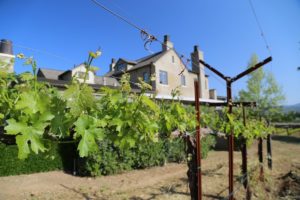

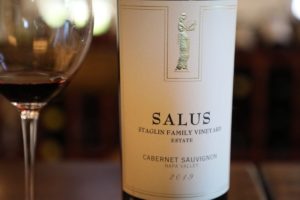 The 2019 Staglin Family Vineyard Salus Cabernet Sauvignon is deep ruby in color; the initial aromas are a bit savory and include dried herbs of sage and thyme along with light cedar. In terms of fruit, there are scents of baked plum, bramble, dark raspberry, dark cherry and a hint of dark chocolate; these scents become quickly more prominent as the wine evolves in the glass. On the palate there are flavors of cherry, blackberry and plum; the focus here is clearly on its flavors with the oak offering a supporting and gentle attribute. And worth mentioning is its structural plushness with tannins sporting a finely-polished and rounded feel. Balanced and easy drinking, this wine shows well five years post vintage at the time of our tasting. Pair with a warm evening, a beef and tomato based ravioli and the anticipation of leaving on international trip the next day.
The 2019 Staglin Family Vineyard Salus Cabernet Sauvignon is deep ruby in color; the initial aromas are a bit savory and include dried herbs of sage and thyme along with light cedar. In terms of fruit, there are scents of baked plum, bramble, dark raspberry, dark cherry and a hint of dark chocolate; these scents become quickly more prominent as the wine evolves in the glass. On the palate there are flavors of cherry, blackberry and plum; the focus here is clearly on its flavors with the oak offering a supporting and gentle attribute. And worth mentioning is its structural plushness with tannins sporting a finely-polished and rounded feel. Balanced and easy drinking, this wine shows well five years post vintage at the time of our tasting. Pair with a warm evening, a beef and tomato based ravioli and the anticipation of leaving on international trip the next day.
The 2014 Salus Cabernet Sauvignon is 93% Cabernet Sauvignon and 7% Cabernet Francs. It sports an elegant bouquet with a noticeable sweetness and ripeness of aroma. There are also subtle floral and herbal aromas at play here. Supple across the palate, this wine shows plenty of fruit including flavors of blackberry and plum. Well integrated tannins complete a fairly soft finish. This bottling drinks extremely well by itself.
The 2005 Salus Cabernet Sauvignon offers black fruit aromas including blackberry and black cherry. On the palate, the wine is supple with an intriguing velvet feel from start to finish. This wine is framed by bright acidity and manageable tannins for early consumption. This vintage was 100% Cabernet Sauvignon.
Resa
Resa in Swedish means journey. The journey of this brand began with two separate labels. Staglin Family Vineyard winemaker Fredrik Johansson began making Grenache in 2013 and in 2017 Shannon began producing Pinot Noir. They combined both of their efforts, creating Resa. Today it produces limited production non Napa Valley wines including Grenache and several bottlings of Pinot Noir.
NOTE: this section has been identified as needing a *major update* including tasting notes for current release wines.
—
In 2007 Staglin purchased the historic Steckter House within their vineyards (built in 1864). It has been carefully restored and now serves as the primary hospitality center and tasting room. A tour and tasting is for serious wine enthusiasts and collectors and will include a quick overview of the vineyards, a visit to the cave and a sit down tasting in the Steckter House. The main dining rooms opens up onto a deck which faces east and overlooks down on their vineyards and parts of Rutherford and Oakville.
And film aficionados take note; Staglin has a direct connection to Hollywood; scenes from the 1998 version of The Parent Trap, starring a very young Lindsay Lohan were filmed at the Staglin’s home located in the hills east of the winery.
Current production is around 7,000 cases annually. Staglin has limited international distribution including to parts of Asia (Japan and Hong Kong). And we have also seen their wines at premium wine shops and restaurants in Bangkok, Thailand. Locally the wines may be found at Oakville Grocery and the neighboring Oakville Wine Merchant. For more information, to purchase wine, to become a club member or to schedule an appointment, visit: www.staglinfamily.com
Estate
Cave






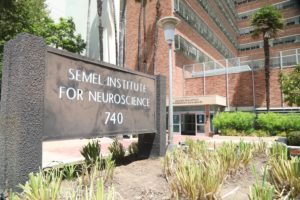
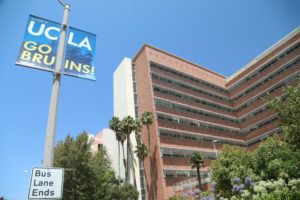
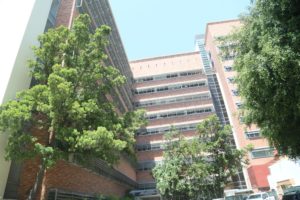
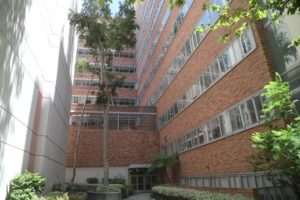
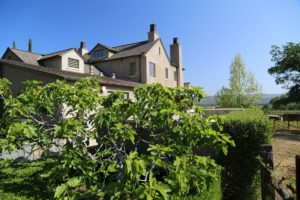
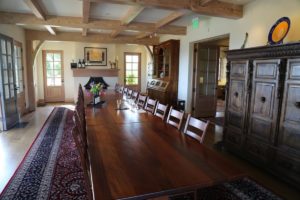
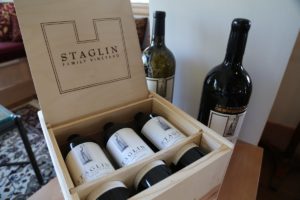
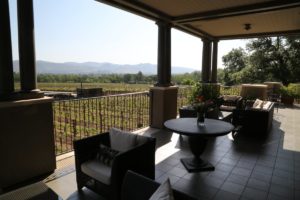
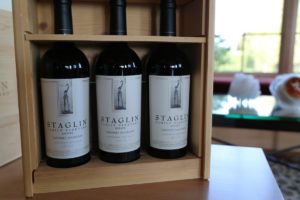
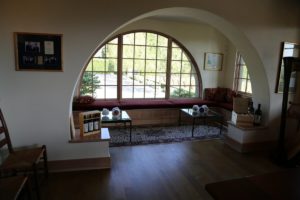
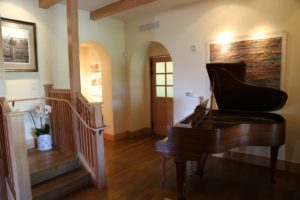
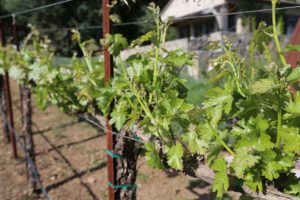
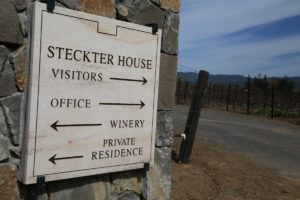
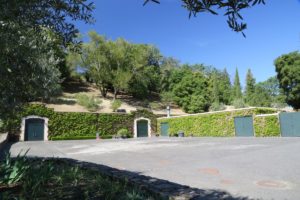
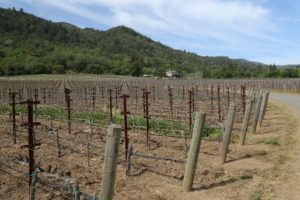
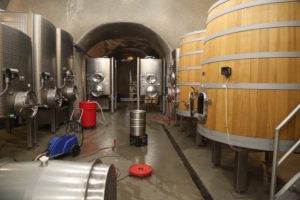
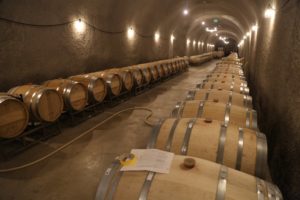
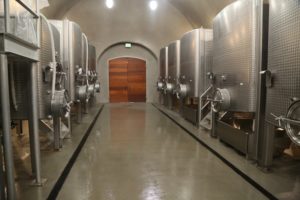
We would like to visit. How do we make a reservation.
We would like to visit, how do we make a reservaron
You could contact Staglin Winery directly to check availability and make an appointment. Hope you were able to visit 🙂